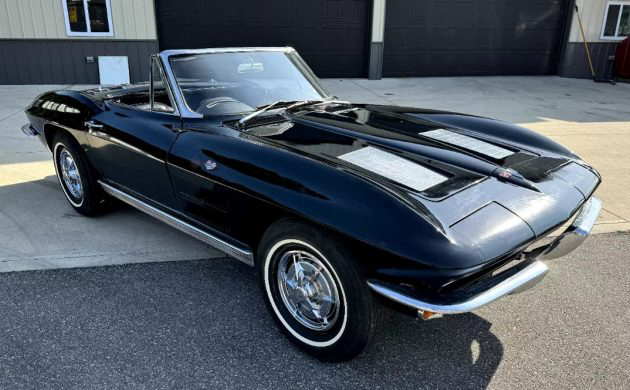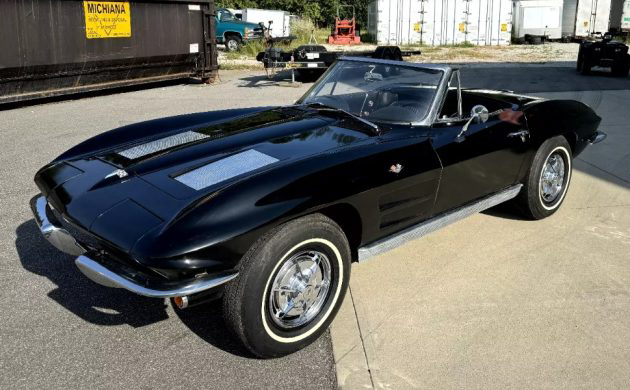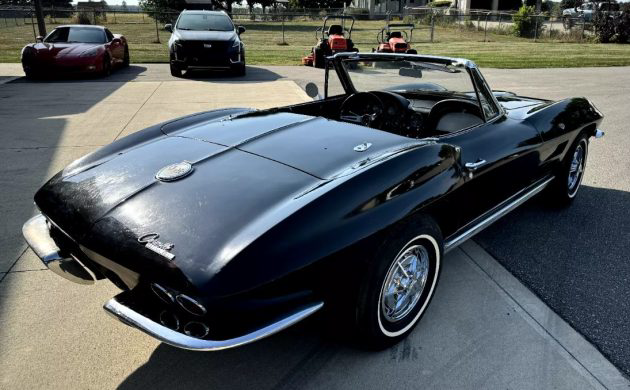Some classics leave potential buyers with tough decisions to make. That might be the case with this 1963 Chevrolet Corvette Convertible. Mechanically, it’s a no-brainer, because this car retains its potent numbers-matching L76 version of the 327ci V8. Therefore, leaving the ‘Vette mechanically original seems obvious. However, the originality of this classic extends to its paint, raising the question of whether preservation is preferable to restoration. The seller has listed the Corvette here on eBay in Mishawaka, Indiana. Bidding has raced to $22,800, and if you are already wavering on whether to pursue it further, the seller’s decision to list this gem with No Reserve may be the tipping point.
The 1963 model year brought the introduction of Chevrolet’s new C2 Corvette, and apart from some key mechanical components, the latest offering shared little with its predecessor. The body was entirely new, suspension upgrades provided drivers with significant handling improvements, and a Coupe became part of the range for the first time. Interestingly, there was some reluctance within Company Management to introduce the Coupe, but with that variant achieving over 49% of total Corvette sales in 1963, it proved a wise decision. Chevrolet offered buyers a choice of seven paint shades, with this Convertible’s original owner selecting Tuxedo Black. The first thing to note is that the deal on this classic doesn’t include a hardtop or a soft-top. Otherwise, it appears to be complete. The second factor to consider is that the seller believes that the paint is original and that the car has never undergone repairs or restoration. A close inspection reveals deterioration, although its generally presentable state may prompt some to preserve this ‘Vette as a proud survivor. However, a faithful restoration would transform this into a jaw-dropping vehicle. If you are wavering on the subject, news below the surface may prove the deciding factor. The frame and birdcage are both solid, with no evidence of penetrating rust. There is dry surface corrosion visible in several shots, and treating this before it deteriorates further will undoubtedly be a priority. That would involve a frame-off process to effectively eliminate the problem and might be all the motivation the winning bidder needs to return the exterior to its former glory. The trim looks acceptable for a driver-grade build, and there are no glaring glass issues.
Purists seeking originality and those considering the long-term investment potential of this Corvette will welcome the news that it is numbers-matching. It would also have been a potent beast in its prime because the first owner splashed an additional $107.60 above the sticker price for the L76 version of the 327ci V8. This motor delivered 340hp and 344 ft/lbs of torque, which fed to the rear wheels via a four-speed manual transmission. That placed a 14.3-second ¼-mile ET within reach, and the needle would hit 139mph before the L76 ran out of breath. This Convertible might retain its original drivetrain, but it has some mechanical shortcomings. The seller confirms that the engine runs, but not well. It suffers from low compression on one cylinder, which appears to be to cause of its woes. They recommend a rebuild during the restoration, which sounds like wise counsel to me.
This classic’s interior, trimmed in Black vinyl, remains presentable if the winning bidder opts to pursue the preservation path. There are no gaping holes in the upholstered surfaces, but there are imperfections in the seatcovers. The carpet on the door trims is faded, and it appears it might be missing at least one minor switch. The parts required to return this interior to a factory-fresh state are readily available, and if the buyer elects to treat the rest of the car to a restoration, I doubt that the interior will escape their attention.
This 1963 Corvette Convertible shows promise as a project candidate, and it will be fascinating to see whether most of you would preserve or restore this classic. I typically prefer originality wherever possible, and this classic remains presentable enough to justify retaining the car as a genuine survivor. However, the frame requires attention to prevent the scale and surface corrosion from developing into penetrating rust. The best approach would be frame-off because that should minimize the chance of it becoming a problem. That may prove the catalyst for total restoration, which is probably the path that most would choose. I have been wrong before, so it will be interesting to gauge your feedback on that vital question.








Don’t go race the 413 😲
Not if one cylinder is half-dead.
I could see just doing what it needs, rebuild the engine and make sure the rest of the mechanics are good, then a major cleaning and chemical restoration. Next step easy peasy drive it like you own it and you love it just the way it is.
Nice car, great engine, and in acceptable condition. I do have one burning question though, what the heck happened to the tops? You could order one of these with soft top only, hard top only, or both tops, but not no top. Just curious as to why someone that apparently took fairly good care of this car wouldn’t have one of the top options. At any rate, the current bid is beyond good, but you can bet that it’s on the way up.
Looks to be a solid car to put back in shape. Rebuilding the original L76 mill is not a big deal. If this can be had under $35K it would be a GOOD DEAL.
Nice, honest presentation here.
I like that there are some undercarriage shots, and some photos of the solid footwell corners – a spot where the birdcage likes to rust.
Needs work, but probably a lot less than the lipstick-on-pig C2s we sometimes see here.
Nitpicky, but the car was built July 1963, not 1962.
The one is in much better shape than the red one from a few days ago. Again, if you are a DIYer a low $30’s price could make a sweet deal.
That frame looks questionable. I’d inspect.